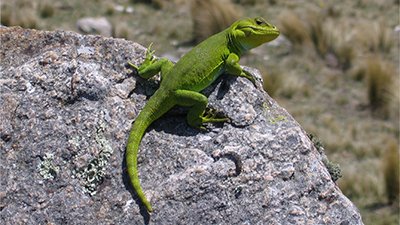African Reptile First With a True Placenta
The skink that breaks the rules
News Source
- NewScientist: “Zoologger: The First Reptile with a True Placenta”
A lizard with a true placenta? That’s what researchers Daniel Blackburn and Alexander Fleming have discovered by dissecting Trachylepis ivensii, a rare species of African skink.
Most people think of reptiles as egg-layers, but about a fifth of them give birth to live young. These live-bearers, however, actually “lay” their eggs inside the mother’s oviducts. There—after deriving various amounts of nourishment from the mother or the yolk—the young are born “live” after the eggshells have thinned or disappeared. Many live-bearing reptiles actually have some sort of placenta to allow the young to receive nourishment through a vascular avenue.
So, if live-bearing lizards typically have some kind of placenta, what is special about this particular skink? Blackburn and Fleming found that the placenta in this case is deeply embedded and intimately associated with the maternal vascular structures. In other words, as placentas go, this one is particularly well-developed.
In the Journal of Morphology they write, “This species has evolved an extraordinary placental pattern long thought to be confined to mammals, in which fetal tissues invade the uterine lining to contact maternal blood vessels. The vestigial shell membrane disappears very early in development, allowing the egg to absorb uterine secretions.”1
Actually, at least two other kinds of skinks possess high levels of placental development. However, T. ivensii’s “pattern of fetal membrane development . . . is unique among vertebrates. T. ivensii represents a new extreme in placental specializations of reptiles, and is the most striking case of convergence on the developmental features of viviparous mammals known.”2
So with the mammalian placenta considered the pinnacle of reproductive evolution, these researchers are describing this skink as the most impressive reptilian example of a great feature that evolved “no fewer than 132 times.” No transitional fossils accompanying this popular evolutionary pathway, however, have been found. Furthermore, the complex design of Trachylepis ivensii’s placenta is not a copy of mammalian placentas but is “unique.” For these reasons, evolutionists invoke convergent evolution, the classic explanation for the existence of common features in organisms for which even the best evolutionary minds cannot invent common ancestry.
Evolutionists invoke convergent evolution, the classic explanation for the existence of common features in organisms for which even the best evolutionary minds cannot invent common ancestry.
Extant live-bearing lizards and other reptiles display an array of placental morphologies. Furthermore, at least two species of skinks contain both egg-laying and live-bearing members.3 While touted as evidence for evolution, these species are actually good illustrations not of evolution but of genetic variation within created kinds. Those dual-mode skink species exist in different climates, each variety being well-adapted to the challenges of its environment. And there is no evidence that those skink populations are changing their reproductive habits at all or evolving into new kinds of creatures.
While we cannot know for certain how many created kinds of lizards God made in the beginning, we could postulate that the genetic ability for egg-laying and live-birth co-existed at least in skinks of the dual-mode types. Whether other variations of Trachylepis ivensii existed in the past, we cannot know. However, the diversity of placental morphology among reptiles is consistent with the biblical concept that the created kinds of creatures diversified to fill the ecological niches of the world. Natural selection (and other mechanisms) would have allowed the best-adapted populations to survive in each habitat.
A skink with a true placenta is no more an example of evolution than is an egg-laying mammal like a platypus. Each has features that appear to “cross” man-made lines of classification, but this should be no surprise since those categories do not represent evolutionary lineages. God’s creatures are not bound by our classification schemes, and the genetic possibilities He built into organisms made diverse adaptations and good ecological “fits” possible.
Further Reading
- Get Answers: Evolution
For More Information: Get Answers
Remember, if you see a news story that might merit some attention, let us know about it! (Note: if the story originates from the Associated Press, FOX News, MSNBC, the New York Times, or another major national media outlet, we will most likely have already heard about it.) And thanks to all of our readers who have submitted great news tips to us. If you didn’t catch all the latest News to Know, why not take a look to see what you’ve missed?
(Please note that links will take you directly to the source. Answers in Genesis is not responsible for content on the websites to which we refer. For more information, please see our Privacy Policy.)
Footnotes
- Daniel G. Blackburn and Alexander F. Flemming, “Invasive Implantation and Intimate Placental Associations in a Placentotrophic African Lizard, Trachylepis ivensi (scincidae), Journal of Morphology, 273, no. 2 (February 2012): 137–159, doi:10.1002/jmor.11011.
- Ibid.
- Brian Handwerk, “Evolution in Action: Lizard Moving from Eggs to Live Birth,” National Geographic, September 1, 2010, http://news.nationalgeographic.com/news/2010/09/100901-science-animals-evolution-australia-lizard-skink-live-birth-eggs/.
Recommended Resources

Answers in Genesis is an apologetics ministry, dedicated to helping Christians defend their faith and proclaim the good news of Jesus Christ.
- Customer Service 800.778.3390
- Available Monday–Friday | 9 AM–5 PM ET
- © 2025 Answers in Genesis






